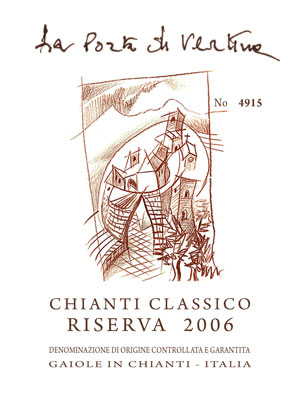A New Star Rises in the East (Part of Chianti)
© by Neil Duarte
Like most devotees of Italian wine, I truly love Chiantis. Over the years I have drunk an untold number of bottles, from the expensive to the more affordable labels. I often tell people who ask me what they should serve that "you really can't go wrong with Chianti."
A short time ago, wine consultant Walter Speller (www.walterspeller.com) introduced me to a new winery that opened only in the last five years in Gaiole in Chianti in the southeastern part of the Chianti Classico area (just north of Siena). La Porta di Vertine (www.laportadivertine.it) was started in 2006 by Dan and Ellen Lugosch. Though the winery is new, the vineyards they acquired had been in use or disuse for many years. The new owners then assembled a star quality team headed by Giacomo Mastretta, the winery's director and oenologist (wine maker). Mr. Mastretta's credentials include education and work experience in France, Argentina, Australia and New Zealand in addition to Italy. Agronomist Dr. Ruggero Mazzilli led the conversion to organic production. To round out the lineup, the legendary Sangiovese specialist, Giulio Gambelli, was the consulting oenologist for the 2006 and 2007 vintages.
With a team such as this you would expect nothing less than superb wine, and from my tasting, which I describe below, they have lived up to the high expectations. But before that, let me digress with some background information about Chiantis. First of all, the term "Chianti Classico" denotes not only that all of the grapes used in the wine have come from the area designated for its production back in 1716 by Cosimo 3rd. It also means that the vinification has followed a rigorous set of production rules. Modern Chianti was introduced in 1850 by Baron Bettino Ricasoli who blended Sangiovese and Canaiolo in an award winning combination. However, today Chianti Classico contains from 80-100 percent Sangiovese grapes. Where less than 100 percent Sangiovese is used, the balance may consist from a variety of red grapes grown in the restricted area such as Canaiolo, Colorino or even Merlot or Cabernet Sauvignon. And finally, the optimum serving temperature for Chianti is between 61-64° F.
Now we move to the wine. La Porta di Vertine de-stems its grapes but does not crush them upon arrival and puts them into concrete tanks. No sulfur is added and long maceration times, up to 60 days, and whole bunch fermentation is often employed.
La Porta di Vertine provided three wines for tasting. Normally I taste in a cellar where I have a number of wines to try. This time I decided to taste the wines with appropriate meals, the setting that most people drink their wines. Fortunately, my wife is a superb cook.
The first wine I tasted was La Porta di Vertine's 2007 Chianti Classico DOCG, a blend of Sangiovese and minimal amounts of Canaiolo, Colorino and Pugnitello. This wine had been fermented in concrete vats without temperature control or yeast addition. The maceration period was three weeks after which it was racked into single or double barriques. Next the wine was transferred into 25 hl tonneaux for ten months followed by twelve months in the bottle.
 | |
| . |
Since most Chiantis are not overpowering, my wife cooked Pollo con spinaci e mozzarella (chicken stuffed with spinach and mozzarella) as the main course. I was amazed with my first taste of the wine. My wife's comment on her first sip was that this was probably the best Chianti she had ever drunk. The wine was dark ruby in color, had a very pleasant bouquet and was exceptional from the first to the last sip. Since this was only the second year of production, I was doubly impressed. I gave this wine a 90 rating and wished that I had more for another time.
Several days later we tried the second Chianti. This was La Porta di Vertine's 2007 Chianti Classico Riserva DOCG, a 100 percent Sangiovese offering. In the Chianti region, approximately 20 percent of the Chianti production (the best) is labeled as "Riserva." Because the fruit used in this particular vintage was so good, the wine was fermented on the stems, whole bunch, and again no external yeast was added. The maceration period was 65 days after which it was racked in Austrian oak 500 liter casks and barriques for 8-10 months. Next it was transferred to 25 hl Slovenian oak casks for 8-9 months further aging. Finally, after bottling, it was aged an additional 12 months in the cellar.
To accompany this wine, my wife prepared as the main course Maiale alla Milanese (breaded pork cutlets). The Riserva was also dark ruby in color, had a stronger bouquet, more body and was very smooth and a bit longer in the finish than the Chianti Classico. Once again, Mr. Mastretta, in combination for this wine with Giulio Gambelli, produced a masterpiece. I rated this wine as a 92.
The last offering from La Porta di Vertine was its 2007 Sassi Chiusi, an IGT blend of Merlot and Cabernet Sauvignon. This wine, labeled as "Rosso Toscana" was enjoyed with a leg of lamb cooked by a neighbor from South Africa. The Sassi Chiusi, darker ruby in color, was big enough to accompany the lamb, had a velvety taste, and a very smooth finish. However, after the superb Chiantis, I looked for a haughtier wine than it showed. Thus, I gave this wine an 88.
Most of the really good Italian wineries have a long and very distinguished pedigree. Though La Porta di Vertine is a mere baby in terms of its age, it definitely appears to be a strong challenger for any of the more prestigious labels. I thank Walter for introducing me to this excellent winery.
March, 2011
